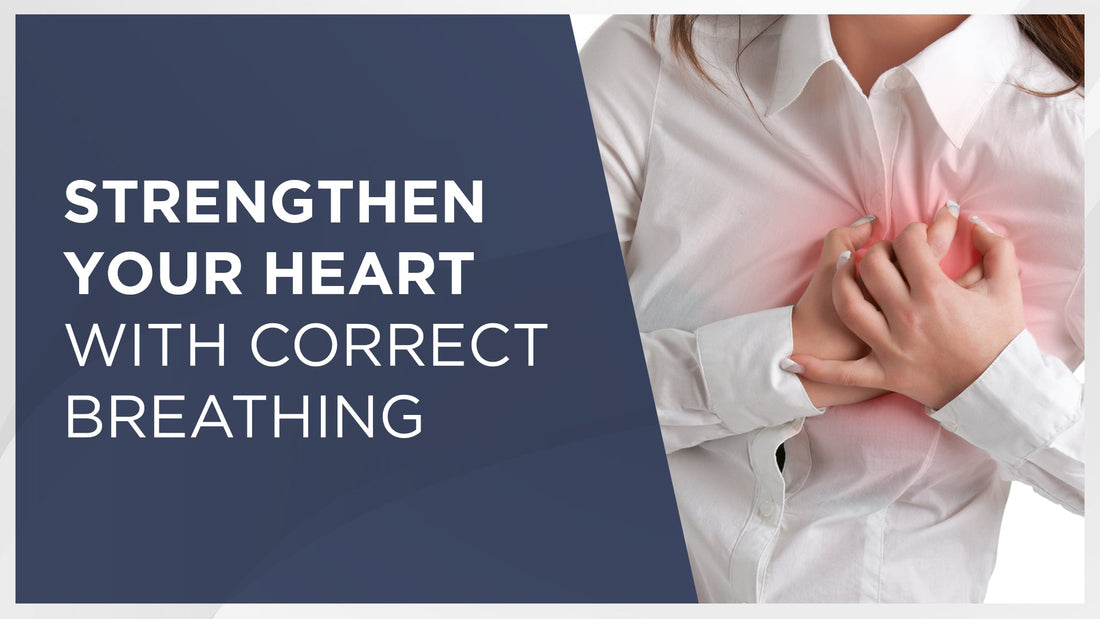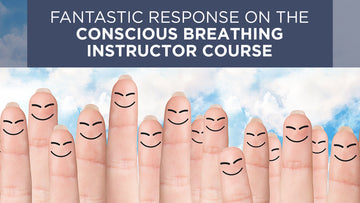
Strengthen your heart with correct breathing
Your heart is situated right between your lungs, and how you actually breathe has a big influence on your heart. Tense, non-rhythmic and stressed breathing makes for a strained, nonrhythmic and stressed heart. Relaxed breathing, on the other hand, ensures a relaxed heart. So when we improve our breathing we also make the life easier for our heart. The normal number of heartbeats at rest is 60–75 beats per minute, therefore a pulse of 70 means that our heart beats 100,000 times in a single day. The rhythm of our heart follows our respiratory rhythm, so if the respiratory rate is high then our pulse is often high too.
An example of this relationship is found in infants who normally take 40-60 breaths per minute, while their hearts beat 120-140 times simultaneously. The same happens when we exercise, since both the pulse and respiratory rate are increased.
Example of how an infant breathes
https://player.vimeo.com/video/228537678
The respiratory rate governs the heart rate

The renowned Yale Professor, Yandell Henderson, who worked in heart and lung research during the first half of the 1900’s, showed in a research project how it was possible to raise dogs’ heart rates from 40 to 200 beats per minute by altering the respiratory rate.
When the alterations were made to the dogs’ respiratory rates, their heart rate rose or dropped accordingly.
In another study on 226 patients with heart failure, it was discovered that breathing and heart function followed each other—the more serious a patients’ heart failure, the more their breathing deteriorated.
| Breathing rate | Heart rate | |
|---|---|---|
| Stressed | 25-30 | 90-100 |
| Infant | 40-60 | 120-140 |
| High intense exercise | 40-60 | 160-200 |
| Conscious Breathing | 6-12 |
40-60 |
Carbon dioxide pressure is more important than blood pressure
We all know about blood pressure. It is measured in mmHg (millimeters of mercury) and a normal blood pressure is considered to be 110-130/80. However, carbon dioxide pressure is not as well known, mainly because it’s difficult to measure and probably also because there has been a lack of interest in breathing in the healthcare system.
An optimal carbon dioxide pressure is between 40 and 45 mmHg, and it is crucial for our well being. The carbon dioxide pressure varies with each breath and therefore provides a much better overview of our current state of health - mentally, emotionally and physically, as compared to measuring blood pressure.
| Carbon dioxide pressure | Breathing | Health status |
|---|---|---|
| 40-45 mmHg | Optimum breathing | Health, energy and harmony |
| 35-39 mmHg | Over breathing | Symptom |
| 30-34 mmHg | Hyperventilating | Diseases |
| 25-29 mmHg | Severe hypeventilation | Serious diseases |
There is a clear correlation between low levels of CO2 and the development of cardiac arrhythmia. The lack of carbon dioxide can lead to both insufficient blood flow, due to constricted blood vessels, and lack of oxygen as explained by the Bohr effect. In a study where 474 healthy subjects hyperventilated for five minutes by taking 30 breaths per minute, 15 percent showed changes in heart rhythm even after 10 minutes of rest.
It is then conceivable and logical to assume that if over-breathing only a few minutes has that effect, over-breathing, for days, weeks and years can cause the same problems on a deeper level, as was seen in the study.
Lower your blood pressure with breathing retraining
Blood pressure is the pressure exerted on the walls of our blood vessels when blood is pumped from our heart to different parts of our body and then back to our heart. Blood pressure varies throughout the day, just like breathing, and the pressure changes depending on what we do.
About a quarter of the adult population in Sweden suffers from high blood pressure, and the majority of those (70-80 percent) take medicine to reduce the pressure. A slightly elevated blood pressure usually doesn’t cause any major problems, and medical treatment is normally only commenced when high blood pressure poses an increased risk, especially for stroke, but also for heart attack, heart failure, kidney disease and decreased circulation in the legs.
It is important to remember, however, that medicine only acts as a suppressive and doesn’t cure the problem. If we stop taking the medication, the high blood pressure will immediately return, since the root cause of the raised blood pressure hasn’t been addressed.
The connection between breathing and blood pressure is well established. In high blood pressure the breathing is fast and shallow. A normal breathing volume at rest it about three to six liters per minute. Several studies show that the breathing volume per minute is twice as high or even higher, 12–15 liters per minute, in those suffering from heart problems.
In high blood pressure and other cardiovascular problems the blood vessels are often narrow. One major reason is low levels of carbon dioxide, which causes the smooth muscles of your blood vessels to constrict. The lower carbon dioxide pressure occurs when we over breathe, since we then exhale too much carbon dioxide.
By slowing down our breathing and apply the seven good habits of Conscious Breathing, we can increase the carbon dioxide pressure and thereby lower the blood pressure.

Could our cholesterol levels be affected by the way we breathe?
High blood pressure increases the mechanical wear and tear on the blood vessels, which increases the production of cholesterol. Cholesterol is produced in order to protect the walls in the vessels against the higher pressure. Over time this makes the walls in the blood vessels harder and stiffer and the heart has to pump harder in order to get the blood out in the body.
Carbon dioxide is a gas that escapes extremely easily through tissues. In the alveoli of the lungs, for example, carbon dioxide travel 20 times faster from the blood to the exhaled air compared to the transfer of oxygen that goes in the opposite direction, from the inhaled air to the blood.
Therefore it is possible that there could be a close connection between increased levels of cholesterol and lowered carbon dioxide pressure. The cholesterol is simply trying to prevent the carbon dioxide from leaving the blood, hence making the walls of the blood vessels thicker.
Optimum carbon dioxide levels makes the blood flow more easily
Carbon dioxide deficiency caused by over-breathing can accelerate the formation of blood clots because it increases levels of platelets (thrombocytes). Blood platelets are normally formed when the blood coagulates and the increased levels of blood platelets make the blood thicker and slow-flowing (increased viscosity).
In one study, twelve healthy medical students were asked to hyperventilate for 20 minutes with a respiratory volume of 36 liters per minute. For one of the tests, the subjects were inhaling normal air, while in another test the inhaled air contained five percent carbon dioxide, i.e., over 100 times more CO2 than in normal air. The study was designed to exclude the effect of any extra muscular work required when hyperventilating. The blood platelet levels increased by eight percent when hyperventilating with normal air, and were unchanged when the subjects were breathing air with five percent CO2 added. The results indicated that it was the low levels of CO2 that occurred during hyperventilation of normal air that resulted in the increased formation of blood platelets.
During surgery there is an increased risk of the blood platelets clumping together to form clots. In a review of 48 studies, a group of researchers found that the number of blood clots is greatly reduced if appropriate techniques for adding carbon dioxide are used during heart surgery.

HRV is a way to measure the heart's ability to adapt
There’s a clear link between a heart with poor adaptability and a stressed breathing pattern. When we inhale, our heart beats faster (our pulse rate increases), and when we exhale our heart beats slower (our pulse rate drops).
Your heart’s ability to adapt to active and restful states is called Heart Rate Variability (HRV), and the better your heart functions, the greater the variability between activity and inactivity.
A stressed heart possesses very little variability, which means that the pulse is basically the same all the time. The heart then lacks the ability to exert extra force and pump faster when needed, or relax and recover when it should do.
One way to increase your heart’s capacity is to extend exhalation, which increases your heart’s rest phase. When you extend your exhalations while maintaining a relaxed breathing pattern, your parasympathetic activity increases and you calm down. It also leads to your HRV being increased, and your heart’s ability to be active or restful at the right time increases. Plus, as you lower your internal stress, your pulse usually drops.
The Relaxator has a positive impact on HRV
FreeCell is a solitaire-based card game that I installed on my computer in order to study my breathing. As it is pretty puzzling and you should solve it while under time pressure, my competitive mind kicks in, which means that I want to perform and do well. As a consequence, I'm getting tense and my breathing is worsened.
Since 2009 I have studied the ins and outs of breathing, and I have worked on improving my breathing in different situations. For study purposes, I played the solitaire game a 100 times. Each time before I started, I had the intention of maintaining a calm, low, rhythmic, relaxed and conscious breathing. How do you think it went!?! NOT GOOD AT ALL!!
Each time it followed the same pattern - during the very first few seconds, I managed to breathe consciously, but then the task took over completely and my breathing "started to live its own life", or at least that was how it felt. And it was only when I was about to solve the card game that I could relax enough to be able to pay attention to my breathing again, and then discover that it was usually quite bad.
Then I tested to solve the card game on six occasions without the Relaxator and six occasions with it, while using a tool to measure my HRV from HeartMath. As you can see in the table and pictures below, the difference became significant. The summary shows that the achieved HeartMath score increased from 140 to 366 with the Relaxator and that the heart worked optimally during 93% of the time compared with only 37% without the Relaxator.
| HeartMath Achievement | Low | Medium | High | |
|---|---|---|---|---|
| Without Relaxator | 140 points | 31% | 32% | 37% |
| With Relaxator | 366 points | 1% | 6% | 93% |
Another test that you can see in the slideshow below was a 19-year-old who studied, 10 minutes where he used the Relaxator and 10 minutes without it. The HeartMath score increased from 168 to 347 with the Relaxator while the heart worked optimally during 96% of the time compared with only 72% when not using the Relaxator.
| HeartMath Achievement | Low | Medium | High | |
|---|---|---|---|---|
| Without Relaxator | 168 points | 9% | 19% | 72% |
| With Relaxator | 347 points | 0% | 4% | 96% |
Slideshow HeartMath with and without the Relaxator








My resting heart rate: 35

In the picture you see my oxygen saturation of 98% (between 96% to 99% is normal), and my resting pulse of 38. The pulse was actually as low as 35, but when I picked up my phone to take pictures, the pulse increased slightly.
Such a low pulse as 35 might have been worrying if I didn’t also experience high energy, feeling healthy and enjoying life. Of course, sometimes I’m also feeling low, just like everyone else, but not as often, and it doesn’t take as long for me to feel well again.
If a low pulse is accompanied by high energy, health and harmony, it is a strong indication that the heart doesn’t need to work as hard to pump around the blood in the body. How high or low my pulse was before I started with Conscious Breathing I don’t know, but since I was quite stressed in general, I’m quite sure it was much higher.
There are many, many people that confirm that improved breathing habits have helped them improve the functioning of their heart, where their resting pulse has decreased, they recover faster after exercise (the pulse decreases faster), blood pressure has been stabilized and circulation improved.
The sound of our heart affects our body
There is nothing new about the fact that we are affected by sounds. The step from being tired and depressed to being excited and energized doesn’t have to be any longer than hearing our favorite song on the radio. A sound that our body listens to around the clock is the beats of our heart. A heart beating quickly tells the body that it needs to be alert.
Listen to these heart sounds and compare the quiet, relaxed sound of 50 beats per minute with the harsh, pounding, insistent sound of 100 beats per minute.
Impaired breathing causes carbon dioxide deficiency and circulation problems
Cold hands and feet indicate that circulation isn’t working optimally and that our body has chosen not to prioritize blood flow to our extremities, but instead to other, more important organs and functions such as the heart, brain and liver.
In a study where the subjects were asked to hyperventilate, they exhibited such severe constriction in the blood vessels in their hands that it was difficult to obtain blood from the finger for blood tests. The problem with hyperventilation is that an imbalance between oxygen and carbon dioxide occurs, as we get too much oxygen and too little carbon dioxide. Carbon dioxide has a widening effect on the blood vessels so that the blood can flow more easily. Consequently, lack of carbon dioxide causes the blood vessels to constrict, which explain phenomena such as higher heart rate, increased blood pressure and circulation problems.
At the Nagoya Kyoritsu Hospital in Japan, more than 200 patients with impaired circulation have been successfully treated with CO2. The patients received footbaths in carbon dioxide-enriched water, which increased circulation in their feet.
BEFORE

AFTER 1 MONTH

AFTER 3 MONTHS

Here are the pictures of a 48-year old woman diagnosed with hypertension who received dialysis for nine years. When she came to the hospital she had open sores on her feet that made her wheelchair-bound. She was given a carbon dioxide enriched foot bath for ten minutes twice a day for three months.
After one month, her wounds and pain had diminished enough to avoid the scheduled amputation. After three months, the wounds were almost healed and she was released from the hospital, able to walk unaided.
Cleanse your blood through diaphragmatic breathing
Our body consists of some 50 trillion cells and half of these, i.e. 25 trillion, are red blood cells. Our lungs are the only organ that receive all the blood and a vital function is to cleanse the blood. Since your lungs are narrow at the top and wide at the bottom, similar to an inverted V, there is the least space for blood vessels in the upper part.
Blood flow is at one liter/min at the bottom and one deciliter/min at the top—i.e., ten times greater at the bottom of the lungs compared to at the top. With every breath we cleanse the blood, but if our breathing is shallow less blood is exposed to the air we breathe in and out.
By improving your breathing habits and breathe low, slow, rhythmically, and in and out through your nose you can cleanse your blood in a more efficient way. Here are some inspiring images showing that we can affect our blood cells through breathing retraining – Incredible effect on the blood with the Relaxator >>
You can check your breathing habits by taking the breathing test. If there is room for improvement you will most likely benefit from doing the 28-Day Program to Better Breathing.
This article is based on the book Conscious Breathing – Discover the Power of Your Breath.







